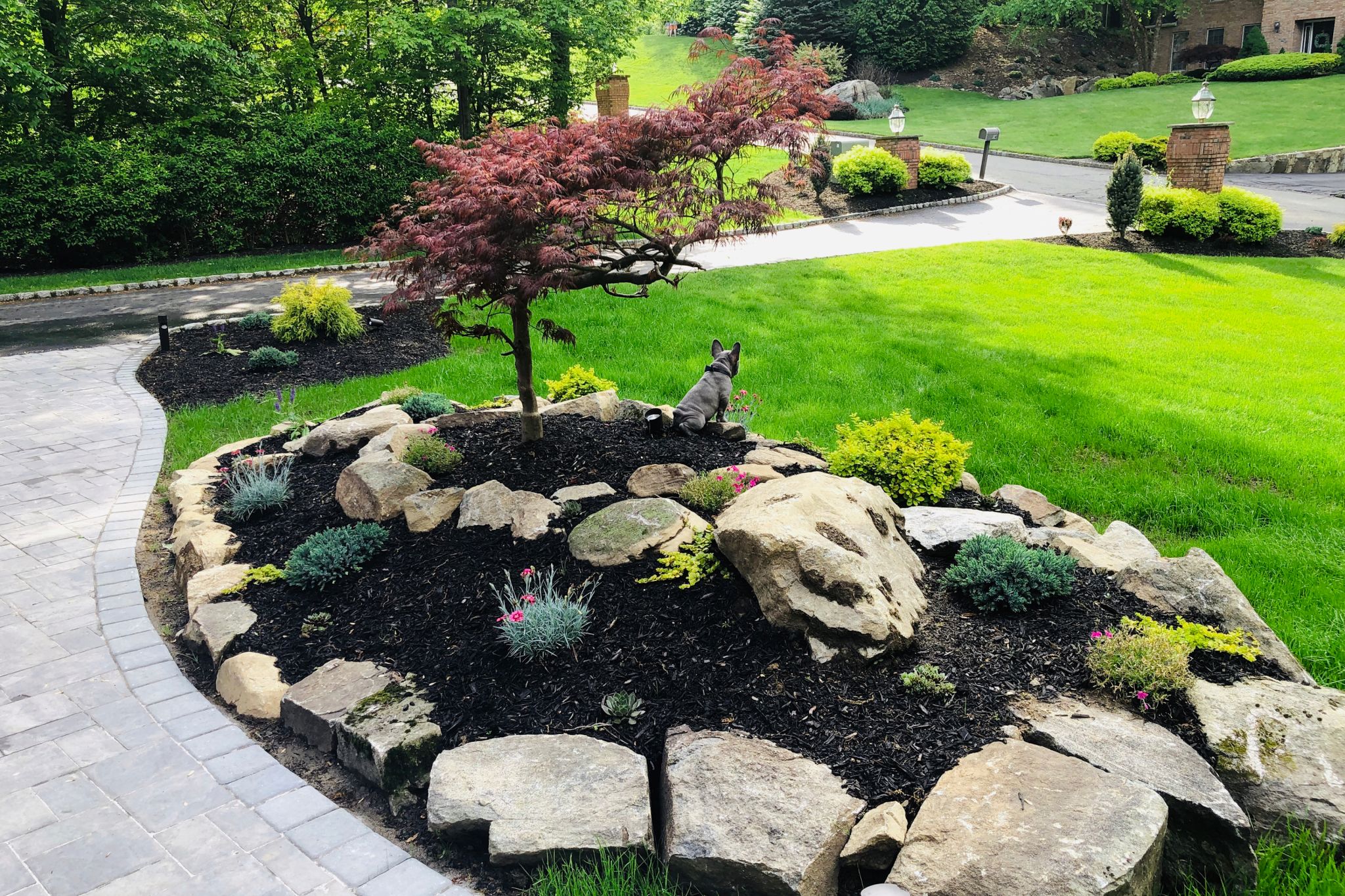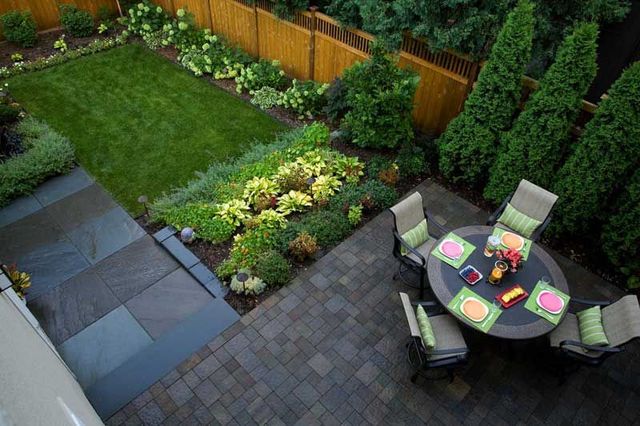Discovering Different Sorts Of Landscaping to Enhance Your Outdoor Environment
Landscaping plays a vital duty in defining exterior rooms. Numerous styles, from conventional yards to modern minimal styles, supply distinctive benefits for enhancing looks and function. Incorporating aspects like xeriscaping and indigenous plants can add to ecological equilibrium. Comprehending the interplay of hardscape and softscape is crucial for producing welcoming environments. The options readily available can be overwhelming, triggering one to assess which design ideal straightens with their vision for an outside sanctuary.
Typical Garden Landscaping

While many modern-day gardens welcome minimalism and indigenous plantings, traditional yard landscape design remains a cherished approach that highlights symmetry, structure, and decorative features. This design commonly integrates official geometric designs, where bushes, flowerbeds, and paths are prepared with accuracy. Central prime focus, such as water fountains or sculptures, attract the eye and supply a feeling of harmony.Traditional landscaping regularly consists of a range of plant types, showcasing seasonal blooms and evergreen components. Traditional shrubs, perennials, and annuals create dynamic shades and textures throughout the year. Furthermore, arches, pergolas, and trellises include upright rate of interest and function as assistance for climbing plants, enhancing the general aesthetic.The use of natural materials, such as rock and timber, more enhances the typical landscape, adding to a timeless top quality. Inevitably, this design welcomes leisure and pleasure, making it a beloved selection for those seeking a picturesque exterior setting.
Modern Minimalist Landscape Design
Modern minimalist landscape design stresses simpleness and performance, identified by open rooms and clean lines. Trick attributes include a limited plant palette and thoughtful hardscape layout that focuses on functionality and visual charm. Effective plant option methods better enhance the minimal technique, creating peaceful outside atmospheres that motivate leisure and consideration.
Trick Qualities of Minimalism
A growing fad in landscape design is the welcome of minimalism, defined by simpleness and capability. Minimal landscape design focuses on tidy lines, open rooms, and a limited shade scheme, promoting a feeling of peace. Elements are carefully curated to prevent clutter, enabling each part to stand out. Making use of natural products, such as stone and wood, enhances the organic feel while maintaining an aesthetic balance. Additionally, minimal designs usually include geometric forms, which can create aesthetic interest without overwhelming the senses. Water functions might be consisted of, acting as focal factors that improve serenity. Overall, minimalism in landscape design stresses the appeal of restriction, permitting nature's fundamental high qualities to beam through in a harmonious exterior environment.
Plant Option Methods
Efficient plant choice is important for attaining the preferred aesthetic in modern-day minimal landscaping. The emphasis must get on simplicity, utilizing a limited scheme of plants that enhance each various other and the surrounding setting. Indigenous plants are usually ideal, as they need less upkeep and water, advertising sustainability. Picking species with differing elevations and textures can add visual interest without frustrating the area. Grouping plants in collections as opposed to scattering them enhances cohesion and strengthens the minimalist motif. Evergreen ranges can provide year-round structure, while seasonal flowers introduce refined color changes. Inevitably, the objective is to create a peaceful outdoor space that personifies peace and harmony via thoughtful plant options.
Hardscape Layout Concepts
Crucial components in hardscape style substantially contribute to the total aesthetics and performance of minimal landscaping. This style strategy highlights tidy lines and understated products, developing an uncluttered aesthetic experience. Secret components consist of paths, outdoor patios, and keeping walls, which not only define spaces yet likewise boost ease of access and use. Using materials such as concrete, rock, and timber prevails, reflecting a natural yet modern-day visual. Incorporating geometric forms and symmetrical formats further reinforces the minimalist ideology, permitting for a harmonious mix with surrounding greenery. In addition, appropriate drain and erosion control are important considerations, guaranteeing longevity and sustainability. Ultimately, effective hardscape design functions as a structure that enhances softscape components while maintaining balance and simpleness in outside atmospheres.
Cottage-Style Landscaping
Cottage-style landscaping uses a fascinating method to developing welcoming outside areas. By integrating captivating plant combinations, this design cultivates a feeling of warmth and whimsy. The focus on relaxing, well-defined areas urges leisure and enjoyment of nature.
Charming Plant Mixes
Several property owners look for to create a picturesque outdoor space, achieving the beauty of cottage-style landscaping often pivots on thoughtful plant mixes. Lively flowers, lavish foliage, and aromatic natural herbs can be skillfully combined to stimulate a sense of fancifulness and nostalgia. Incorporating lavender, daisies, and foxgloves produces a vivid tapestry that attracts pollinators while offering a wonderful scent. Including ornamental turfs like miscanthus can add texture and activity, matching the softer flowers. Additionally, mixing seasonal and yearly plants warranties continual color throughout the seasons. The use of climbers, such as clematis or honeysuckle, can boost upright interest. In general, these mixes not only beautify the landscape but additionally cultivate a enchanting and inviting environment.

Comfortable Outside Areas
Developing comfortable outdoor areas requires a careful blend of comfort and charm, matching the lively plant combinations found in cottage-style landscape design - Bbq Island Installation. These locations frequently include welcoming seating plans, such as weathered wood benches or supported chairs surrounded by lavish greenery. Soft lights, like fairy lights or lights, adds warmth, changing the space right into a relaxing retreat. Integrating elements such as trellises embellished with climbing roses or fragrant natural herbs improves sensory experiences. Furthermore, pathways made from rustic stones invite exploration and link with nature. Decorative touches like birdbaths or whimsical garden art add to a sense of whimsy. Ultimately, the goal is to develop a captivating ambience that encourages relaxation and pleasure of the charm bordering these comfy outside havens
Xeriscaping for Water Conservation
Exactly how can neighborhoods balance visual landscaping with the pushing requirement for water preservation? Xeriscaping emerges as a feasible service, advertising lasting practices that minimize water use while improving outdoor elegance. This landscape design approach concentrates on utilizing drought-resistant plants native to the region, which require substantially less water than traditional yards. By incorporating compost and reliable irrigation systems, xeriscaping lowers dissipation and overflow, additional conserving precious water resources.Communities can create aesthetically attractive landscapes via cautious preparation, choosing a varied array of textures and colors that thrive in dry problems. In addition, xeriscaping urges the use of ornamental rocks and ornamental crushed rock, offering functional and eye-catching options to yard lawns. As communities embrace this eco-friendly method, they not only lower their water usage however likewise promote biodiversity and resilience in their neighborhood communities. Ultimately, xeriscaping offers as a presentation of the consistency between visual charm and environmental obligation.
Hardscape Layout Components
Hardscape style elements play an important role in boosting outdoor areas by giving framework and functionality. These non-plant attributes, such as patio areas, sidewalks, decks, and walls, create visual passion while serving practical functions. Making use of materials like concrete, stone, and brick, hardscaping contributes to the overall visual allure and durability of a landscape.Incorporating hardscape aspects can specify locations within a yard, leading activity and urging social interaction. A well-placed path can connect different sections of the yard, while maintaining wall go to my blog surfaces can take care of altitude adjustments and prevent erosion.Furthermore, hardscape layout can improve ease of access and security, providing steady surfaces for walking or lounging. Reliable combination of hardscape elements complements soft landscaping, making certain a well balanced outside environment. Eventually, thoughtful hardscape style enhances not just the appeal of outside rooms yet also their use, making them more welcoming and practical for site visitors and property owners alike.
Outdoor Living Spaces
While outside home provide a smooth mix of comfort and nature, they work as essential extensions of a home, enhancing lifestyle and leisure. These areas can include patio areas, decks, or outside kitchens, made to foster leisure and home entertainment. Landscape Lighting Installer. By including functional furniture and trendy design, home owners develop inviting environments for gatherings or peaceful evenings.The assimilation of shade frameworks, such as pergolas or awnings, protects versus the elements while preserving an open feeling. Fire pits and outdoor heating systems extend functionality into cooler months, supplying heat and setting. In addition, integrating illumination attributes boosts the area's use after sunset, original site producing an enchanting evening atmosphere.Landscaping components, such as pathways and borders, further define these locations, directing motion and including aesthetic allure. Inevitably, outside home transform backyards right into functional retreats, advertising a way of life that welcomes both nature and comfort
Indigenous Plant Landscaping
Native plant landscape design emphasizes making use of aboriginal plants to develop harmonious and lasting exterior settings. This technique not only enhances biodiversity however likewise preserves water and reduces the need for chemical plant foods and pesticides. By choosing plants that are indigenous to a specific area, home owners can ensure that their landscapes are well-adapted to neighborhood dirt and environment conditions, causing lower maintenance requirements.Additionally, indigenous plants supply necessary environments for local wildlife, including birds, bees, and butterflies, promoting ecological health. Landscape makes that incorporate these plants usually feature naturalistic formats that resemble neighborhood communities, cultivating a local color and link to the environment.Furthermore, indigenous plant landscape design can contribute to soil security and disintegration control, making it an eco accountable selection. Generally, this practice not only enhances outside spaces however likewise sustains the regional environment, developing a sustainable equilibrium between human task and nature.

Regularly Asked Concerns
Exactly How Can I Select the Right Landscaping Design for My Home?
Choosing the best landscaping design for a home includes assessing the building's style, climate, and personal choices. Retaining Wall Installation. Investigating various designs and speaking with experts can provide guidance to produce a harmonious outside space customized to private requirements
What Is the Ordinary Cost of Professional Landscaping Providers?
The ordinary expense of expert landscaping solutions generally ranges from $1,000 to $5,000, depending on project intricacy, dimension, and place. Home owners should take into consideration getting several quotes to assure they obtain reasonable rates and top quality service.
Exactly how Usually Should I Keep My Designed Yard?
The regularity of keeping a designed yard normally relies on the plants and attributes present. Normally, regular maintenance every couple of weeks is recommended, with seasonal tasks enhancing in frequency during peak expanding periods for suitable wellness and aesthetics.
Are There Landscaping Alternatives for Little Urban Spaces?

Different landscaping choices exist for tiny metropolitan rooms, consisting of upright gardens, container plants, and rooftop gardens. Incorporating these aspects can maximize limited areas while providing plant, boosting visual appeals, and improving air quality in metropolitan settings.
What Plant kingdom Are Finest for Drawing In Regional Wildlife?
The ideal plants for bring in neighborhood wildlife consist of indigenous blooming types, berry-producing bushes, and varied turfs. These plants supply important food and habitat, fostering a thriving community that sustains various birds, insects, Recommended Site and small mammals. Numerous property owners look for to develop a stunning outside room, achieving the appeal of cottage-style landscape design often pivots on thoughtful plant mixes. Producing comfy outdoor areas requires a mindful mix of comfort and appeal, enhancing the dynamic plant mixes found in cottage-style landscape design. Native plant landscape design highlights the use of aboriginal vegetation to produce lasting and unified exterior atmospheres. Landscape creates that incorporate these plants usually include naturalistic formats that simulate neighborhood ecological communities, cultivating a sense of location and connection to the environment.Furthermore, indigenous plant landscaping can add to soil stability and disintegration control, making it an eco responsible selection. Numerous landscaping alternatives exist for small urban areas, including upright yards, container plants, and rooftop gardens.